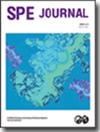Modeling of Cutting Rock: From PDC Cutter to PDC Bit—Modeling of PDC Cutter
IF 3.2
3区 工程技术
Q1 ENGINEERING, PETROLEUM
引用次数: 23
Abstract
The main purpose of this paper is to present our polycrystalline diamond compact (PDC) cutter model and its verification. The PDC cutter model we developed is focused on a PDC cutter cutting a rock in 3D space. The model studies the forces between a cutter and a rock and applies the theory of poroelasticity to calculate the stress state of the rock during the cutting process. Once the stress state of the rock is obtained, the model can then predict rock failure by the modified Lade criterion (Ewy 1999). This work also developed a trial-and-error procedure to predict cutting forces, and the stress state of a rock before cutting process is also considered. A complete verification of the cutter model is conducted. The model results (i.e., predicted cutting forces) are compared with measured cutting forces from cutter tests in multiple published articles. The major influencing factors on cutting forces—backrake angle, side-rake angle, depths of cut, worn depth (or wear flat area), and hydrostatic pressure—are all studied and verified. A good agreement between the model results and cutter test data is found, and the overall mean relative error is approximately 15%. The influence of inhomogeneous precut stress state of a rock is also studied. Overall, the cutter model in this paper is complete and accurate. It is ready to be integrated into a PDC bit model.切削岩建模:从PDC切削齿到PDC切削齿的钻头建模
本文的主要目的是介绍我们的聚晶金刚石复合片(PDC)刀具模型及其验证。我们开发的PDC刀具模型专注于PDC刀具在三维空间中切割岩石。该模型研究了刀具与岩石之间的力,并应用孔隙弹性理论计算了岩石在切削过程中的应力状态。一旦获得岩石的应力状态,该模型就可以通过修正的Lade准则(Ewy 1999)预测岩石破坏。这项工作还开发了一种预测切削力的试错程序,并考虑了切削过程前岩石的应力状态。对刀具模型进行了完整的验证。将模型结果(即预测的切削力)与多篇已发表文章中刀具测试测得的切削力进行比较。对影响切削力的主要因素——后倾角、侧倾角、切削深度、磨损深度(或磨损平面面积)和静水压力——进行了研究和验证。模型结果与刀具试验数据吻合良好,总体平均相对误差约为15%。还研究了岩石非均匀预切应力状态的影响。总体而言,本文中的刀具模型是完整和准确的。它已准备好集成到PDC钻头模型中。
本文章由计算机程序翻译,如有差异,请以英文原文为准。
求助全文
约1分钟内获得全文
求助全文
来源期刊

SPE Journal
工程技术-工程:石油
CiteScore
7.20
自引率
11.10%
发文量
229
审稿时长
4.5 months
期刊介绍:
Covers theories and emerging concepts spanning all aspects of engineering for oil and gas exploration and production, including reservoir characterization, multiphase flow, drilling dynamics, well architecture, gas well deliverability, numerical simulation, enhanced oil recovery, CO2 sequestration, and benchmarking and performance indicators.
文献相关原料
| 公司名称 | 产品信息 | 采购帮参考价格 |
|---|
 求助内容:
求助内容: 应助结果提醒方式:
应助结果提醒方式:


